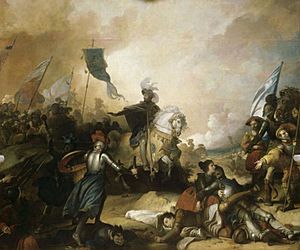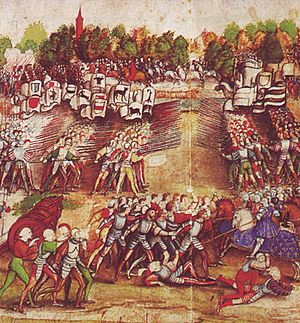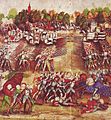Battle of Marignano facts for kids
Quick facts for kids Battle of Marignano |
|||||||||
|---|---|---|---|---|---|---|---|---|---|
| Part of the War of the League of Cambrai | |||||||||
 Francis I Orders His Troops to Stop Pursuing the Swiss, a painting by Alexandre-Évariste Fragonard |
|||||||||
|
|||||||||
| Belligerents | |||||||||
| Commanders and leaders | |||||||||
| Strength | |||||||||
|
22,200 men
|
||||||||
| Casualties and losses | |||||||||
| 5,000 dead Unknown wounded |
10,000 dead Unknown wounded |
||||||||
The Battle of Marignano was a very important battle that happened on September 13–14, 1515. It was the last big fight in the War of the League of Cambrai. The battle took place near a town called Melegnano, which is southeast of Milan in modern-day Italy.
This battle was between the French army, led by their new king, Francis I, and the Old Swiss Confederacy. The French army had strong heavy cavalry (soldiers on horseback) and powerful cannons. The Swiss soldiers were famous for being the best foot soldiers in Europe at that time. The French also had German landsknechts (mercenary soldiers) who were rivals of the Swiss. Later, their allies from Venice joined the fight.
Contents
Why the Battle Happened
For many years before this battle, the Swiss had been very successful in wars. They had taken control of Milan, which was a key city for France in Italy. After winning a battle in 1513, the Swiss put Massimiliano Sforza back on the throne of Milan. This made Milan a "protectorate" of Switzerland, meaning Switzerland protected and controlled it.
King Francis I of France wanted Milan back. To get there, his army had to cross the Col d'Argentière in the Alps. This was a huge challenge because they had to pull 72 heavy cannons over mountains on new roads they built! It was a route no one had used for cannons before.
Once they reached the plains of Piedmont, the French army surprised their enemies. A daring cavalry attack led by Jacques de la Palice and Chevalier Bayard captured the Pope's commander, Prospero Colonna. This surprise attack, along with the sudden appearance of the French army, shocked the Swiss and the Pope.
At first, the Pope and the Swiss tried to make a peace deal with King Francis. Many Swiss soldiers were tired of fighting and wanted to go home with the treasures they had collected from their victories. A peace agreement was made that would give Milan back to the French, and many Swiss soldiers started to leave.
However, new Swiss troops arrived who didn't agree with the peace treaty. There was a lot of disagreement among the Swiss forces. A powerful church leader named Matthäus Schiner, who was a big enemy of King Francis, tricked the Swiss into fighting. He made a small fight seem much bigger, convincing them to attack the French army, even though the French were much stronger. The Swiss army then marched out of Milan in organized groups, ready for battle.
The Battle Begins
The Swiss army met Francis's forces near a small, burned village called Marignano. The area was full of vineyards, farms, and orchards. The French were not expecting a battle because of the peace agreement. King Francis was trying on new armor when his scouts told him the Swiss were coming.
The French army quickly got ready. They formed three main groups. The first group, led by Charles III, Duke of Bourbon and Marshal Gian Giacomo Trivulzio, took positions on two small hills. This group had crossbowmen, German Landsknecht foot soldiers, and soldiers with early guns called arquebusiers. Their cannons were set up in a curved line.
Behind them, King Francis I of France himself led a group of cavalry and 6,000 more Landsknechts. The last group, further back, was led by Charles IV, Duke of Alençon. The French army had a good mix of soldiers with long spears (pikemen), guns, and cavalry. The Swiss army, however, was mostly made up of pikemen and had very few cannons or cavalry.
As the sun began to set, the Swiss attacked in three dense groups of pikemen. They were used to charging quickly and overwhelming their enemies. At Marignano, they started by sending a small group to charge the French cannons. Their plan was to capture the cannons quickly and then use them against the French.
At first, the Swiss attack pushed back the German Landsknecht defenders and captured some cannons. The Swiss moved so fast that the French cannons couldn't fire effectively. But then, French cavalry attacked the Swiss from the side, forcing them back. The French cavalry then had to retreat themselves after losing many soldiers.
As night fell, smoke and confusion filled the battlefield. It was hard to tell who was winning. King Francis himself, often with Bayard by his side, led many furious cavalry charges. These charges pushed back the Swiss again and again. Many French commanders were hurt or killed in the desperate night fighting. The fighting stopped in the darkest hours, and both armies pulled back to reorganize. Some Swiss soldiers even left the battlefield during the night. But those who stayed were determined to fight on the next morning.
The next morning, the battle started again. The French cannons were ready. The Swiss, encouraged by their actions the night before, charged the cannons again. This time, the cannons fired massive shots that tore through their lines, slowing them down. But the brave Swiss kept closing ranks and pushing forward. The German Landsknechts were pushed back again, but the cannons firing at close range stopped the Swiss from going further. Another French cavalry charge, led by Bayard, forced the Swiss to give ground.
The Swiss were confused by the cannons but still determined. They changed their attack to focus on Alençon’s group on the left side. This attack also failed. King Francis later wrote to his mother that the French cavalry made "thirty brave charges" against the stubborn Swiss.
The battle finally turned when Venetian forces, led by Bartolomeo d'Alviano, arrived in the middle of the morning. With their attacks failing everywhere and their ranks broken, the Swiss slowly gave ground. They retreated in a huge, organized square, showing amazing discipline even as they lost.
This battle was a big victory for King Francis. The Swiss were outnumbered and had fewer cannons, so this outcome might seem expected. However, in the years before, the Swiss had often won even when they were at a disadvantage. The French victory was not easy; the battle was very close until the Venetian soldiers arrived.
The main reasons the Swiss lost were that they couldn't capture the enemy cannons early on and the arrival of the Venetians. Also, the Swiss had problems with their discipline and command. Earlier in 1515, each Swiss captain could decide if his company would keep fighting or retreat. This made it hard for the Swiss army to act as one unit. Their leaders would vote on what to do, but sometimes the soldiers decided to attack anyway, hoping for treasure, even if their captains had agreed not to.
What Happened After

For France
King Francis I was very proud of this victory. He ordered a special medal to be made that said, "I have vanquished those whom only Caesar vanquished." He even asked to be knighted on the battlefield by the famous Chevalier Bayard, in the old style. Marshal Gian Giacomo Trivulzio, a soldier with 40 years of experience, called Marignano the "battle of giants." He said all his previous battles had been "child’s sport" compared to it.
Marignano showed that French cannons and heavy cavalry were stronger than the Swiss infantry's famous spear formations. France gained control of Milan and its important castle, the Castello Sforzesco, which was key to controlling the region of Lombardy. Massimiliano Sforza and his Swiss soldiers had to hide in the castle. They only gave up when French engineers dug tunnels and placed explosives under the castle walls. Massimiliano Sforza then went to live in luxury in exile, paid for by the French.
For Switzerland
The Swiss army lost Milan, but they kept control of some nearby areas. The Battle of Marignano ended the Swiss dream of controlling Milan. After this battle, the Swiss Confederacy never went to war against France or Milan again.
In fact, the Swiss Confederacy hardly went to war at all after 1525. (Except for one area, Vaud, being taken by the canton of Berne in 1536). Many historians say this was because of the "lesson learned" at Marignano. But also, the Swiss Reformation (a big religious change) in the 1520s divided Switzerland. The different parts of Switzerland were busy fighting each other during the European Wars of Religion. Also, Swiss mercenary groups suffered other big defeats between 1515 and 1525.
The "Perpetual Peace"
After long talks, a peace treaty was signed between the Swiss (the Thirteen Cantons and their allies) and King Francis I of France in Fribourg on November 29, 1516. This treaty was called the "Perpetual Peace" (Ewiger Frieden in German).
In this treaty, the Swiss Confederacy gave up all their claims to Milan. In return, France paid them 700,000 gold crowns as payment. Both sides agreed not to help each other's enemies in the future. They also agreed to use a system to solve any future disagreements. France offered more money if the Swiss would give up some mountain territories, but the Swiss said no.
The treaty also gave the Swiss special trading rights in Milan and Lyon. Only the Ossola valley went back to Milan. The other mountain areas that the Swiss controlled are still part of Switzerland today, like the canton Ticino.
The "Perpetual Peace" with France lasted for a very long time, almost three centuries! It was only broken during the French Revolutionary Wars when France invaded Switzerland in 1798. This treaty led to a long period of close ties between Switzerland and France. The Swiss also stopped being as close to the Holy Roman Empire.
Another step in their friendship was a military agreement in 1521. This agreement made Swiss mercenary groups a regular part of the French army, like the famous Gardes Suisses. This arrangement also lasted for three centuries. Swiss soldiers even fought in Napoleon's army when he invaded Russia in 1812. Finally, in 1848, when Switzerland became a federal state, it became illegal for Swiss citizens to serve in foreign armies.
Other Important Things
In 1515, King Francis I met with Pope Leo X in Bologna. They made an agreement that gave Francis the power to choose French bishops (church leaders). Also at this meeting was the famous artist and inventor Leonardo da Vinci. Francis convinced Leonardo to come back to France with him. He gave Leonardo a nice home, the Clos Lucé manor, and a good income.
A religious leader named Huldrych Zwingli was also at the Battle of Marignano. He was a church leader in Glarus. In Glarus, there was a debate about whether young men who wanted to be mercenaries should fight for France or for the Holy Roman Empire and the Papal States. Zwingli wanted to stop Swiss men from fighting on both sides of the war, which had happened before and meant "brothers fighting brothers."
Zwingli had supported the Pope before Marignano. Even after the battle, he was against the peace with France and kept supporting the Pope. But public opinion in Glarus changed to be very pro-French after the peace treaty of 1516. So, Zwingli had to leave his position in Glarus. He then worked in Einsiedeln and later in Zürich.
Because of his experiences in the Italian War, Zwingli became strongly against mercenary service. He agreed with Erasmus of Rotterdam that "war is sweet only to those who have not experienced it." Zwingli also blamed Cardinal Schiner for causing the disaster at Marignano. He started to preach against powerful church leaders, which were the first signs of his ideas that would lead to the Swiss Reformation in the years after Marignano.
Legacy and Commemoration
The Battle of Marignano is remembered in several ways. There is a stone carving (bas-relief) of the battle by Pierre Bontemps on Francis I's tomb at Saint-Denis Basilica. There is also a painting by Antoine Caron and a famous song (chanson) called La guerre by Clément Janequin. A Swiss hero named Hans Bär is shown in a painting on the tower of the Basel City Hall.
Images for kids
-
Dying Swiss, sketch by Ferdinand Hodler (ca. 1898) for his Retreat from Marignano fresco (1900).
See also
 In Spanish: Batalla de Marignano para niños
In Spanish: Batalla de Marignano para niños




